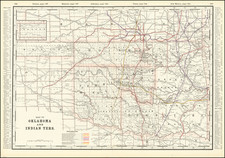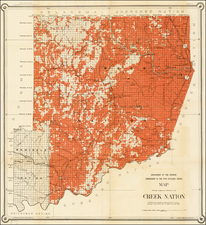Indian Territory, delineated by the Department of the Interior's General Land Office under the oversight of Commissioner N.C. McFarland, and principally drafted by G.P. Strum, stands as a critical cartographic record of a transformative period in the American West. The map, intended to complement Thomas Donaldson's "Public Domain", categorizes the land's divisions, from military reservations to the arterial roads that transected the vast expanse.
The late 19th century was a watershed moment for the American West, marked by both relentless expansionism and the US government's ever-evolving policies regarding Indigenous peoples. Central to this was the concept of the 'Indian Territory', an administrative region designated for the relocation and settlement of Native American tribes. This map traces the boundary of these Indian reservations, starkly capturing the geopolitical reality of the day – one where Native nations were confined to delineated spaces amidst the sprawling American frontier.
G.P. Strum's cartographic technique embodies the precision of the General Land Office's draughtsmanship. Beyond mere geographical representation, the map distinguishes between subdivided townships, the capitals of various Native nations, smaller towns and villages, and military reservations. Such granularity offers insights into the social and administrative structure of the Indian Territory, providing a lens through which one can discern the intersections of Native sovereignty, settler colonialism, and federal oversight.
The inclusion of roads and trails provides yet another layer of historical context. These pathways signify not only the movement of people, goods, and ideas but also the intertwining of Indigenous and settler lives. By charting these routes alongside the territories of various Native nations and other landmarks, this map serves as a testament to a dynamic and often contentious landscape, shaped by policies, migrations, and the enduring spirit of its inhabitants.










![[Original photograph:] Native American group image, possibly in Indian Territory, with White Settlers](https://storage.googleapis.com/raremaps/img/small/82871.jpg)
![[Portrait of Osage Saucy Chief]](https://storage.googleapis.com/raremaps/img/small/92655.jpg)

![(Native American Photograph) [Fox On The War Path (Ke-wuk-o-car-war-ry), a Pawnee man of Indian Territory]](https://storage.googleapis.com/raremaps/img/small/93109.jpg)
![(Native American Photograph) [Outdoor scene of six Wichita Indians playing cards at a ranch in Minco, Oklahoma Territory, with horse-drawn carriages in the background]](https://storage.googleapis.com/raremaps/img/small/93106.jpg)